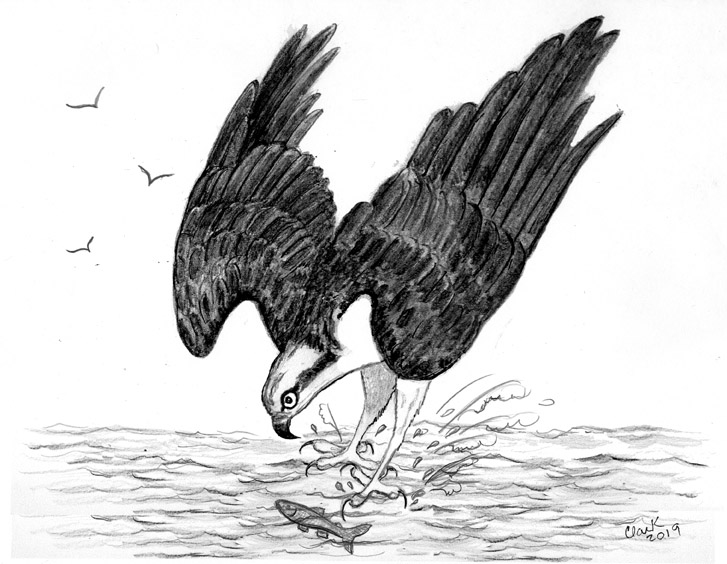
Dear Bird Folks,
I know Ospreys are fish eaters, but I would like to know about their fishing skills. What makes them so good at catching fish?
– Carlos, Needham, MA
It’s simple, Carlos,
The key to the Osprey’s fishing success is to get up early, use fresh worms and wear a stupid-looking hat. No, wait, that was me back in the day when I used to go fishing. (Now I think fish look better swimming in the wild instead of lying at the bottom of a plastic bucket.) Ospreys are indeed masters at fishing and they need to be. The top three items on an Osprey’s menu are: fish, followed by fish, and occasionally, a bit of fish. It estimated that 99% of an Osprey’s diet is plain old fish. I’m not sure what the remaining 1% of their diet consists of, but I’ve heard it’s cinnamon Pop-Tarts. (Probably to kill the fish taste.)
It’s funny how birds have evolved to take advantage of different food sources. Geese appear to have the best plan. They just walk/swim around and eat grass and plants as they go. There is seemingly no effort or stress involved. Ospreys, on the other hand, must take to the air and search the local ponds and bays for a fish that has carelessly swum too close to the surface. When a fish is spotted, the bird has to plunge into the cold water at 30 MPH. Then, if it’s lucky enough to catch the fish, it has to become airborne again, only now it’s wet and it is carrying an angry fish. It’s a lot of work for one meal. Maybe Ospreys should think about switching to grass.
Like all birds of prey, or most birds for that matter, Ospreys have excellent vision. It is sometimes said that their eyes are three to five times more powerful than ours. This seems a little high to me. Oh sure, they have good vision all right, but so do we (or in my case, used to). Osprey eyes are just better at finding fish under water. In addition, the birds are somehow able to adjust to light refracting through water. (They don’t fall for the old bent pencil in the glass of water trick.) But unlike us, Osprey’s eyes are fixed in their sockets; they can’t move them like we can. In other words, no matter what you say to an Osprey, it won’t roll its eye at you. (Sometimes, I wish my wife had Osprey eyes.)
The birds’ first challenge is to find a fish. Next, it has gauge how deep it is. Unlike loons, Ospreys aren’t able to swim under water, and thus can’t grab anything that’s more than a few feet down. Size is also an issue. Tiny fish aren’t worth the effort, but if the fish is too big, the birds won’t be able to fly away with it. They must find a fish that is just right (aka, the Goldilocks method). When an acceptable fish is spotted, the bird dives down, folding its wings back and extending its talons forward as it enters the water. Like a pair of swimming goggles, nictitating membranes (translucent eyelids) protect the bird’s eyes from the splashing, while its nostrils close tight to keep water out. That’s important. It would be embarrassing if, instead of catching a fish, the bird came up coughing and reaching for a towel.
How good are Ospreys at catching fish? While success rates vary, a good average is about 50%. This is impressive, since they don’t even use fresh worms or wear stupid-looking hats. Of course, grabbing a fish and getting out of the water are two different things. To make sure Ospreys aren’t victims of “the one that got away,” each foot is equipped with four super-sharp talons and toes that are coated with little Velcro-like spikes, called “spicules.” Also, like a contortionist, the birds are able to twist one of their front-facing claws backwards in order to gain an even better grip. Finally, with its powerful wings, the bird will take to the air. As it flies, it will shake off excess water, wet dog style, while at the same time maneuvering the fish to face forward. They say facing the fish forward helps with aerodynamics, but I think they simply want to allow the fish to enjoy the view. Ospreys are very considerate that way.
The remarkable thing about the Osprey’s fishing skills is that they are self-taught. You know the saying, “teach a person to fish and you feed him or her for a lifetime”? (Yes, I updated it.) Well, that doesn’t apply to Osprey. Apparently, no one teaches them anything. For the first few months the adults deliver all the food the family needs. Then one day the parents decide that everyone should to be own their own. The kids have to either figure out the fishing thing or go hungry. (Talk about cold. Even I wouldn’t do that.)
Tornado vs. Osprey update:
I don’t know how many Osprey nests you have in Needham, Carlos, but we have quite a few here on Cape Cod, and a couple of weeks ago we had even more. Then something nutty happened. A rare and totally surprising tornado (or two) ripped through parts of the area. In addition to losing trees, power lines and one motel roof, several Osprey nests came down. While crews were busy clearing trees, Barnstable’s Cape Wildlife Center and Eastham’s Wild Care tended to the displaced birds. It was an exhausting couple of days, but Wild Care reports that with the help of the power company and town officials, most of the homeless birds were placed back in their nests, where they were immediately tended to by their stressed-out parents. Yay! Nice job, wildlife people. All of us appreciate your efforts in saving the baby Ospreys. Well, all of us except for maybe the fish. They’re not big fans.